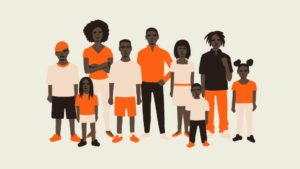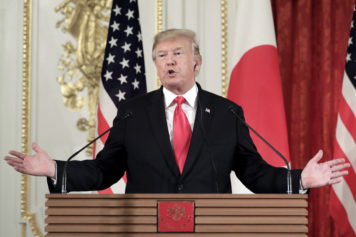
Photo via The Atlantic screen shot
On any given day in the United States, one in 10 Black men in their 30s is in prison or jail. In fact, one out of three Black men of all ages can expect to serve time at some point in his life. That figure is one in six for Latino men and one in 17 for white men.
This racial disparity is hardly a function of crime. Over the past quarter-century, U.S. incarceration rates have nearly doubled, while crime rates have been cut in half.
Our criminal justice system isn’t broken. This glaring racial inequity is actually a result of how the justice system was designed to work — a system with an undeniable historic connection to slavery that was outlawed a century and a half ago. Any meaningful conversation about ending mass incarceration in the U.S. must include discussing racism in our prisons, our legislation, our courts, our police departments, our schools, our neighborhoods, and in our everyday lives.
How did we get to this place? Although slavery ended in 1865, America came up with plenty of reasons to lock up large numbers of Black people in the years that followed. The legal justification was established in the Black Codes — loitering and vagrancy laws passed after the Civil War to restrict freedom. The moral justification developed as white society promoted racialized stereotypes that related Black bodies to animalistic brutes to be feared, especially by white women.
The not-so-hidden financial justification was the desire to bring Black people back to tobacco and cotton fields. After the end of slavery, prisons became a new path to provide free or cheap labor for plantations. Within a century, that labor was used also for governmental contracts and private industry. Along with the new sharecropping system after the Civil War, the Southern plantation system kept churning out product — all at the expense of Black humanity.
The “war on drugs” and era of mass incarceration
The disproportionality of Blacks in prison grew over the following decades, becoming further entrenched in the 1970s and ’80s. As a backlash to communities struggling for civil and human rights — for themselves and for others — new laws took hold that made it easier to keep Black people in shackles and chains.
In 1971, President Richard Nixon declared a “war on drugs” to quell social unrest across the country — feeding a new racially tinged narrative about “inner city” crime for the constituency he called his “silent majority.” The war on drugs fueled a surge in prison populations, which continued to soar with the passage of state-level legislation like the Rockefeller drug laws in New York, and, in the 1980s, tough-on-crime measures, such as “three-strikes” laws and other draconian punishments for drug offenders.
Drug-related crimes represent the single biggest increase in incarceration rates over the past several decades. Statistical analysis show rates of drug use (and selling) to be similar across racial lines, however, Blacks are arrested on drug charges at rates that are three to five times as high as those of white adults.
Structural racism intensifies for people of color at every stage in the criminal justice system. These communities experience an over-policing that white communities — whether poor or not — never encounter. Young Black men are shot dead by police at 21 times the rate of young white men, according to the investigative journalists at ProPublica. And a recent Gallup poll shows that one in four young Black men recalled unfair treatment by police within the past 30 days.
For people of color, arrests often turn into imprisonment, whereas whites may face probation or shorter sentences for committing similar acts. To make matters more tragically comedic, the recent shift to legalize marijuana in several states has created a new class of mostly white entrepreneurs while thousands of young Black men and women remain imprisoned or with criminal records for using or selling the same substance.
This is business as usual in our criminal justice system — an accepted paradigm that encourages mass incarceration of people of color to continue. Though less crude than during and after Reconstruction, American politicians, media, and law enforcement continue to draw on the well-practiced art of stereotyping the “other” to justify discriminatory treatment.
Today, the United States has both the largest number of human beings behind bars (more than 2.4 million in federal, state, county, and other facilities) and also the highest percentage of its population (nearly one out of 100) locked away. Although Black men make up 6 percent of the population, they now account for nearly half of all prisoners.
After people are released from prison, their punishment continues. They face discrimination in applying for jobs, housing, and public assistance. Many are barred from voting for the rest of their lives.
Opportunity for change
Racial inequity pervades the U.S. criminal justice system, the political arena that governs that system, and the society that allows this injustice to continue. Interrupting that cycle to end mass incarceration requires change in every one of those spaces. And there are a few, but important, opportunities to push for that needed transformation.
Over the past eight years, we’ve seen an ebb in the total number of people incarcerated in the United States. The slight but significant declining trend began not because enlightened political leaders finally understood the devastation that these policies have caused, but because of the great recession of 2007. Economic woes meant that many states could no longer afford the cost of building and maintaining prisons.
This opening has allowed advocates and organizers to seize the part of the public narrative that has now forced and encouraged some mainstream political leaders to publicly wrestle with this issue. On the 2016 presidential campaign trail, we’ve seen politicians on both sides of the aisle calling for an end to the era of mass incarceration — not simply for economic reasons but because of the destruction it has caused, disproportionately for the poor and people of color.
In local communities, organizations like the American Friends Services Committee are providing support to formerly incarcerated people and their families. In the South, AFSC is blessed to work with other organizations, faith-based groups, and individuals committed to improving opportunities for people in and out of prison.
In Baltimore, our Friend of a Friend program works in several prisons in Maryland, providing training to inmates on nonviolent conflict resolution while supporting an environment where they can study the causes and effects of mass incarceration and how they can participate to dismantle this system. After they’re released from prison, Friend of a Friend accompanies them as they transition back into the larger community, connecting them to ongoing community organizing work.
In Atlanta, we have started a restorative justice program that helps young people who’ve been charged with crimes get involved with real community work, such as designing programs to prevent their peers from walking down the same path, as an alternative to having a criminal offense on their record.
Programs like these help, one person at a time. But working toward policy changes that affect thousands remains critical. Advocates across the country continue to chip away at the problem of mass incarceration from different angles, whether calling for decreasing sentences, decriminalizing certain drugs offenses, and alternatives to incarceration programs, to name just a few.
As individuals, communities, and organizations come together to challenge the imprisonment of our brothers, sisters, and neighbors, we can’t ignore the central role that racism plays in our justice system.
In this effort, we must continue to respect the humanity of every person caught up in this modern-day outgrowth of slavery. And we must ensure that the narrative is not one that treats the incarcerated as simply perpetrators, but as survivors of a system designed to control people based on the color of their skin and the need of those with power to withhold it from those without. In this way, we can do more to ensure that we move toward a conclusion in this painful chapter in this nation’s history.
Kamau Franklin has been a dedicated community organizer and movement attorney for over 20 years, first in New York City and now based in the South. For 18 years he was a leading member of a national grassroots organization dedicated to the ideas of self-determination and Malcolm X. He worked on various issues, including youth organizing and development, police misconduct, creating sustainable urban communities and led electoral campaigns. He blogs at grassrootsthinking.com and can be followed on twitter @kamaufranklin


